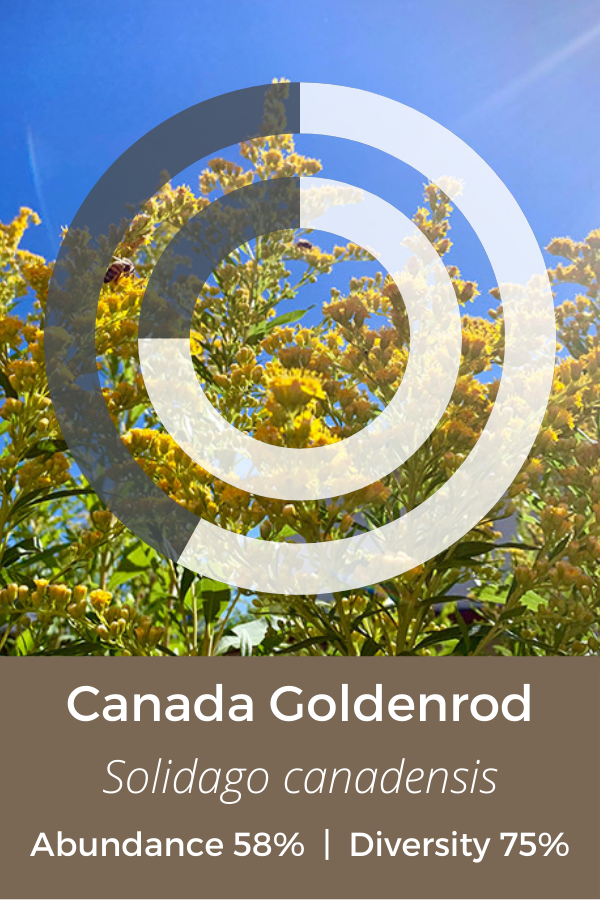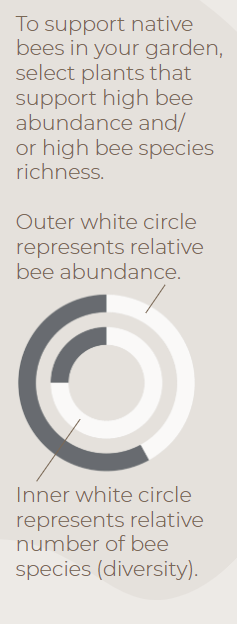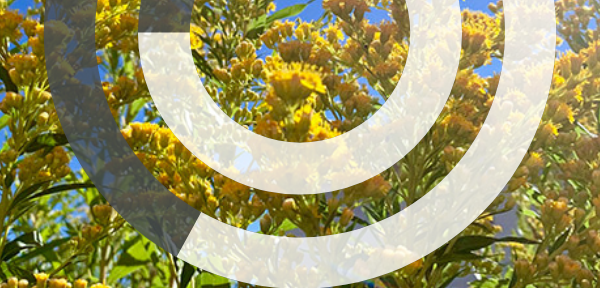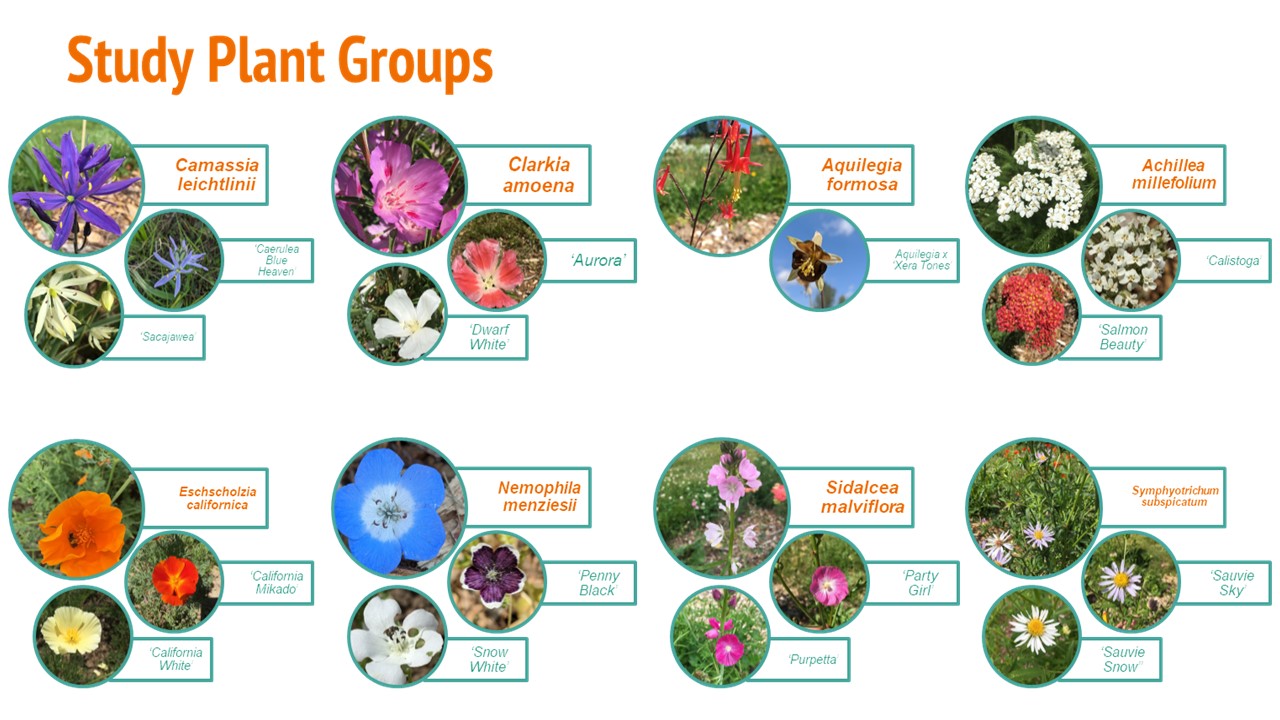The Garden Ecology Lab’s Pollinator Plant PR Campaign Presents….. Canada Goldenrod!
The Garden Ecology Lab is releasing a series of plant profiles of the top 10 Oregon native plants for pollinators, based on Aaron Anderson’s 2017-2019 field trials of 23 Oregon native plants. We will feature one plant per week for 10 weeks, this is week 5! Profiles will include photos, planting information, and will highlight common pollinators of each plant.

no rights reserved (CCO).
Plant Facts
- Scientific Name: Solidago canadensis*
- Life Cycle: Perennial
- Growth Habit: Erect, arching
- Bloom Duration: July-October
- Hardiness Zone: 3-9
- Special Traits: Moderately drought tolerant, deer and rabbit resistant
- Light requirements: Prefers full sun, but tolerates some shade.
- When to plant: Plant starts in the Spring, or sow seeds directly in the Fall.
Pollinator Facts
- Canada goldenrod provides both nectar and pollen to its insect visitors.
- In Aaron’s research, Canada goldenrod was found to be associated with a species of long horned bee, Melisoddes microstictus and bees from the genus Bombus (bumblebees).
- Other common visitors to Canada goldenrod are Northern Checkerspot butterflies, Field Crescent butterflies, Wavy-Lined moths, and Common Grey moths.

*A Note on Taxonomy
Canada goldenrod is often treated as a complex, or group of species, under the scientific name Solidago canadensis. In western North America, the complex includes S. elongata, S. lepida, and S. altissima. Tall goldenrod, S. altissima, is not native to Oregon, so when we refer to Solidago canadensis in Oregon, this only includes S. lepida “Cascade Canada Goldenrod” and S. elongata “Western Goldenrod”.
Goldenrods (the genus Solidago) are known to be a very difficult plant to identify to species, because they have a great amount of variation in their morphology within even a single species. To avoid any concerns about what species you’re getting when sourcing goldenrod or other native plants, we highly recommend purchasing plants from a local native plant nursery or grower that sources their seeds within your region!
Canada Goldenrod’s Native Range in Oregon
Oregon is home to Solidago lepida "Cascade Canada Goldenrod" and Solidago elongata, "Western Canada Goldenrod". Both of these species are found throughout Oregon, though they were previously thought to be geographically distinct. Maps and legend acquired from the Oregon Flora Project, with Imagery Sourced from Google.
Canada Goldenrod as a pollinator plant
Canada goldenrod grows in prairies, meadows and riparian areas across Canada and the United States. Great for erosion control, hedgerows and pollinator gardens, Canada goldenrod will fill space with hardy foliage year round and present a showy display of golden flowers in the late summer. The pyramidal inflorescences are lined with tiny composite flowers that brim with nectar and pollen. Goldenrod supports many late season butterflies, moths, bees, beetles and some wasps.
Goldenrod is a wonderful late-flowering plant for pollinators; it hosts a moderate abundance and a high diversity of insect visitors. During its peak bloom, you can often find numerous different insects foraging on goldenrod. We love combining goldenrod with Douglas aster for a beautiful late-season floral display of yellow and purple, though it also compliments shorter annual species as well.


Infographics developed by LeAnn Locher, Aaron Anderson, and Gail Langellotto.
Abundance and Diversity Calculations. Bee abundance was calculated using estimated marginal means of bee visitation to each of our study plants from 5-minute observations conducted from Aaron’s 2017-2019 field seasons. Estimated marginal means (EM Means) were assigned to categorical values and averaged across years to yield the following categories: 0% = Very Low =EM mean below 0.49; 25% = Low = EM mean of 0.50 to 0.99; 50% = Moderate = EM mean of 1 to 1.49; 75% = High = EM mean of 1.50 to 1.99; and 100% = Very high = EM mean above 2.0.
Bee diversity was based on the total sum of species collected on each of our study plants from 2017 to 2019. A Chao 2 Estimator was used to estimate total expected species richness for each plant; Chao 2 estimates were then used to create categorical values, as follows: 0% = Very Low = 9.99 or lower; 25% = Low = 10 to 14.99; 50% = Moderate = 15 to 19.99; 75% = High = 20 to 24.99; 100% = Very high = 25 or higher.
Did you know?
Although this goldenrod is often blamed for people’s late summer allergies, the culprit is in fact ragweed! Ragweed and goldenrod have different pollination styles: ragweed produces masses of airborne pollen in an attempt to reach other ragweed plants by wind. Since goldenrod has evolved with pollinators to carry its pollen in a targeted fashion, goldenrod produces less pollen, very little of which is airborne.
Canada goldenrod has additionally been used as a plant medicine in many cultures; it was used as a substitute for English tea during the American Revolution for its pain-relieving and diuretic effects. Goldenrod flowers are edible and make a colorful garnish that make a beautiful addition to garden salads.
Photos from the field
Tune in next week for the next edition of our Pollinator Plant PR Campaign.

















1 Comment
Add Yours →Looking forward to the PR campaign! I need help “selling” these plants to colleagues.